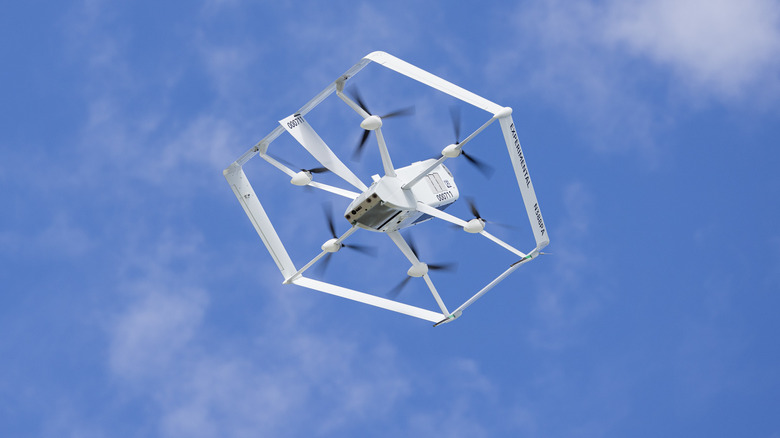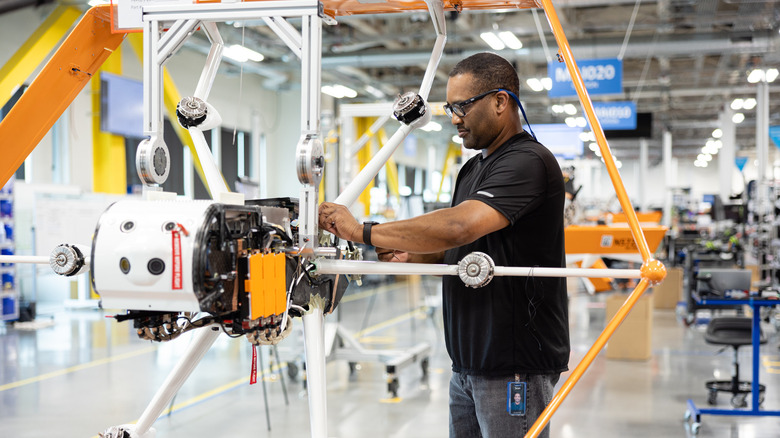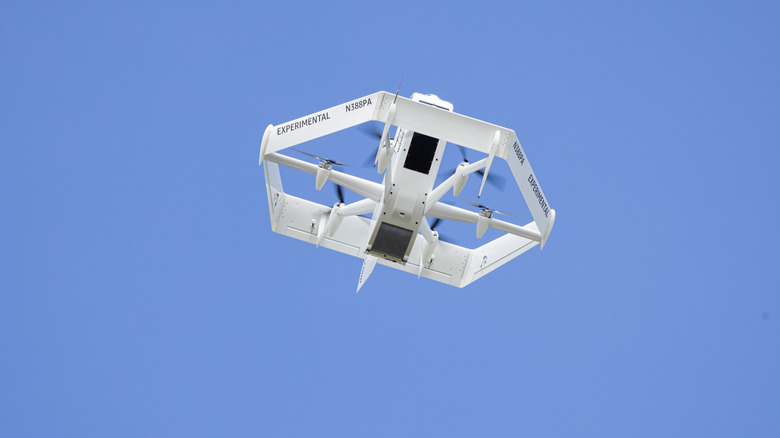Here's Where Amazon's Prime Air Delivery Drones Will Be Dropping Orders Next
Every year, Amazon ships billions of packages to customers around the globe. Delivering those packages is a combination of Amazon's own drivers, national postal services, and companies like UPS. With delivery being such a huge part of its business, the company is always on the lookout for cheaper and more efficient ways to get packages into customers' hands.
One futuristic delivery method the online retailer has been toying with involves drones. The service is named "Amazon Prime Air" and could revolutionize the company's distribution arm. The autonomous airborne vehicles could simply pick up a box, fly it to a pre-arranged drop-off point, then fly back to the warehouse to recharge or pick up another package. Drop-off points could theoretically be anywhere of a reasonable size with open-air access — like a back garden. Amazon's drones fly with six degrees of freedom, are capable of taking off and landing vertically, and contain an on board AI to keep deliveries on track. There's no point in streamlining your system if the method you switch to is worse — so the design is heavily based on dealing with common hazards like strong winds and power lines.
Drones aren't the only flight-based method of delivery Amazon has considered. Back in 2016, it filed a patent for what looks like a small hot air balloon with a few drone-like elements. Although the delivery balloon doesn't seem to have gone anywhere, it does potentially have some logic behind it. Regular drones have a lot of positives, but a major downside of their use is the noise they produce. Even at a distance, one small drone can sound similar to a swarm of angry bees. With the volume of packages Amazon moves daily, the noise pollution a horde of its drones would produce is difficult to comprehend.
The drones took a while to arrive
Although it was announced years ago, Amazon's drone idea took a while to get off the ground. It has hit a number of technical and legal snags. As a result, we're only just in the early rollout phases, around six years on from the project first being announced. Technical hurdles the company had to overcome involved designing a drone that could operate autonomously, make deliveries within 30 minutes, carry at least five pounds, and have a range of ten miles. Amazon says more than 24 prototypes were designed, built, and tested in nine years.
Amazon also had to contend with a slew of regulatory and legal hurdles. You can't just operate a vast array of drones without government bodies like the Federal Aviation Administration getting involved. Amazon's drone plans eventually got the go-ahead from the FAA in 2020. David Carbon, Vice-President of Prime Air, described the approval as "an important step forward" before adding that it "indicates the FAA's confidence in Amazon's operating and safety procedures for an autonomous drone delivery service that will one day deliver packages to our customers around the world." Amazon was not actually the first company to receive government approval for a drone delivery service. UPS led the way after getting the green light from the government body in October 2019.
Last year, Amazon scaled back its drone operation in the U.K., cutting staff numbers at Amazon Prime Air by around 100. The pilot scheme had been going for over three years, and there isn't a definite answer on why staff numbers were cut and the project was seemingly wound down. Despite the downgrade, Amazon did insist it wasn't abandoning its U.K.-based drone delivery service and that it would continue even after the cuts.
Amazon Prime Air is finally coming to the US
As drone deliveries scale back in the U.K., they're beginning to ramp up in the United States. The company says that customers in Lockeford, California, and College Station, Texas "will be among the first to receive Prime Air drone deliveries in the U.S." Customers in those locations are already being contacted by Amazon and offered the service, which is free at the time of writing.
Not all of Amazon's items can be delivered by the service. Weight, size, and other factors affect what a drone can and cannot take. Still, Amazon claims to offer "the largest selection of items to ever be available for drone delivery," and those eligible objects will be clearly indicated on the site. When an order is placed, Amazon provides an estimated delivery time and tracking details. Customers who decide to wander out to their back garden at the time of delivery will see the drone hovering at a "safe distance" over the designated delivery area before releasing the package and flying away. Delivery speeds are apparently lightning fast. The drones are capable of flying at up to 50 mph while carrying a five-pound object. There isn't much traffic at 400 feet in the air, so customers are unlikely to see many delays while looking at the Amazon package tracker. In total, Amazon Prime Air deliveries are expected to take less than an hour.
There are concerns about drones taking jobs from delivery drivers, but they shouldn't be too worried. The retailer claims its new service will actually create jobs. Despite there being thousands of objects available for drone delivery, five pounds is a pretty big weight restriction. Equally, not everyone lives within ten miles of an Amazon distribution center, so even a mass rollout wouldn't affect most deliveries.


